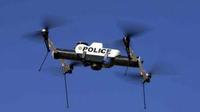-
Seattle debates use of drones by police
The debate between law enforcement and privacy advocates over the use of UAVs is now taking place in Seattle; since President Obama signed a bill in February pushing the Federal Aviation Administration (FAA) to allow the use of civilian drones in America by 2015, many law enforcement agencies have been preparing to use drones
-
-
Florida man prevented from attacking NYC landmarks for lack of funds

A Florida man who wanted to attack a landmark in New York City, but lacked the funds to carry out his plan, was arrested on terror charges, according to federal prosecutors; Raees Alam Qazi, 20, told the officers who arrested him that he tried to contact al Qaeda, and that he was motivated by reading the online magazine Inspire which is produced by al Qaeda in the Arabian Peninsula
-
-
Is stricter gun-control legislation more likely after Newtown shooting?
An American politics professor, specializing in the relationship between public opinion and legislation, says that the relationship between mass shooting and gun-control legislation is not straightforward;thus, there was a spike in support for gun control after Columbine, but not after the Virginia Tech, Tucson, or Aurora shootings; “The Newtown shooting is different than those shootings in some respects, especially because many of the victims were young children. But the magnitude of this tragedy may not be sufficient to produce stricter gun-control legislation at the federal level”
-
-
City is sued over ban on fracking
An industry group representing oil and gas companies filed a lawsuit Monday against a city in Colorado which has banned hydraulic fracturing; fracking has increased U.S. energy production, but it has also caused contamination of ground water; scientists say fracking may also cause earthquakes
-
-
U.S. cuts budget for nuclear monitoring at foreign ports
In 2003 the United States decided to install radiation detection equipment in 100 large ports around the world, and train local personnel in using the equipment, so that ship containers could be scanned for nuclear material before the ship left for the United States; so far, equipment has been deployed in forty-two ports; after GAO criticism of the quality of the scanning equipment and of lack of coordination between two similar container scanning programs, the National Nuclear Security Administration’s 2013 budget will be cut by 85 percent, and further installations will be canceled
-
-
NBC crew freed after a firefight between the kidnappers and anti-regime rebels
A NBC reporter and four men from his film crew were freed Monday from kidnappers in Syria which kept them tied up, blindfolded, and repeatedly threatened to kill them for five days
-
-
Sandy relief bill says rebuilding effort should take into consideration climate-related risks
The $60 billion Sandy relief bill being debated this week in the Senate does not specifically mention the words climate change or global warming, but it implicitly raises topics and themes which are part of the climate change discussion; the bill says that federal, state, and local agencies engaged in the post-Sandy rebuilding effort should take into consideration “future extreme weather events, sea level rise and coastal flooding”
-
-
A 1978 NY state law requiring updated emergency preparedness plans largely ignored
In 1978, a New York state law was passed which required that annually updated plans for the restoration of vital services in the event of a major storm; in the three decades since, the law has been largely ignored due to tight budgets and politicians unwilling to prepare for a storm which may or may not hit
-
-
Divisive constitution appears to have been ratified in referendum
Unofficial results, reported by Egypt’s state media, from Saturday’s first-round vote in the constitutional referendum show that the Islamist-backed draft constitution passed by about 56 percent of the vote in ten of Egypt’s twenty-seven provinces; the result in the first round may not be seen as a sweeping mandate, but the second round promises the Islamists a larger majority: the first round included many of Egypt’s big cities, such as Cairo and Alexandria, where the anti-Islamist groups are powerful; the second round will take place mostly in rural provinces, where the Brotherhood’s influence is much stronger
-
-
Privacy advocates succeed in delaying drone purchase by California country sheriff

Congress earlier this year passed legislation earlier this year ordering the Federal Aviation Administration (FAA) to accelerate the approval of the use of unmanned aerial vehicles (UAVs) for law enforcement and other domestic purposes, and, law enforcement agencies around the country are moving to purchase drones; Alameda Country, California planned to buy a drone, but action by the ACLU and the Electronic Frontier Foundation forced the county to hold a public hearing on drone use and formulate guideless for, and set limits on, drone use by police
-
-
Aussies debate terrorism and freedom of speech
Inspireis an English- language jihadist magazine created by al Qaeda in the Arabian Peninsula (AQAP); so far nine editions of the magazine have been produced; the magazine was produced and edited by two Americans, Anwar al-Awlaki and Samir Kahn — both were killed by an U.S. drone in Yemen in August 2011; last Monday, a resident of Melbourne, Australia was charged with possessing terrorism-related materials because he was found to have four issues of Inspire in his possession
-
-
EPA issues new soot pollution standard over industry’s objections
The Environmental Protection Agency (EPA), acting under court order, on Friday issued a new standard for soot pollution; the agency estimates the cost of complying to be between $53 million and $350 million – and the estimated benefits to be between $4 billion and $9 billion; utilities, manufacturers, chemical companies, and the oil and gas industry asked for a delay in issuing the rule, arguing it would be costly to implement
-
-
Breaking news: Gunman kills 27, self, in Connecticut elementary school
A 20-year old Newtown, Connecticut man entered the Sandy Hook Elementary School in town and began shooting; police says that, so far, there are twenty-seven dead and scores of injured; among the dead are twenty students and six staff members; most of the students were killed in the classroom of the gunman’s mother, who was also shot and killed; police reports that so far it appears that there is only one person injured who requires hospitalization
-
-
High Russian official: Assad losing the ground war
The Assad regime does not have many friends left, and yesterday one of them admitted that Assad was losing the war; Mikhail Bogdanov, the deputy foreign minister of Russia, said the regime faced possible defeat to the rebels, adding with unusual frankness for a diplomat: “One must look facts in the face”
-
-
Senate intelligence committee approves 6,000-page report on CIA interrogation of terrorists
Senate panel completes a 6,000-page report into the techniques used by the CIA in interrogating terrorists; the report will now be submitted to the administration for review; GOP members of the committee object to the report being made public
-
More headlines
The long view
What Does Netflix’s Drama “Adolescence” Tell Us About Incels and the Manosphere?
While Netflix’s psychological crime drama ‘Adolescence’ is a work of fiction, its themes offer insight into the very real and troubling rise of the incel and manosphere culture online.
A Shining Star in a Contentious Legacy: Could Marty Makary Be the Saving Grace of a Divisive Presidency?
While much of the Trump administration has sparked controversy, the FDA’s consumer-first reforms may be remembered as its brightest legacy. From AI-driven drug reviews to bans on artificial dyes, the FDA’s agenda resonates with the public in ways few Trump-era policies have.
The Center Can Hold — States’ Rights and Local Privilege in a Climate of Federal Overreach
As American institutions weather the storms of executive disruption, legal ambiguity, and polarized governance, we must reexamine what it means for “the center” to hold.
How to Reverse Nation’s Declining Birth Rate
Health experts urge policies that buoy families: lower living costs, affordable childcare, help for older parents who want more kids
Foundation for U.S. Breakthroughs Feels Shakier to Researchers
With each dollar of its grants, the National Institutes of Health —the world’s largest funder of biomedical research —generates, on average, $2.56 worth of economic activity across all 50 states. NIH grants also support more than 400,000 U.S. jobs, and have been a central force in establishing the country’s dominance in medical research. Waves of funding cuts and grant terminations under the second Trump administration are a threat to the U.S. status as driver of scientific progress, and to the nation’s economy.
The True Cost of Abandoning Science
“We now face a choice: to remain at the vanguard of scientific inquiry through sound investment, or to cede our leadership and watch others answer the big questions that have confounded humanity for millennia —and reap the rewards.”
